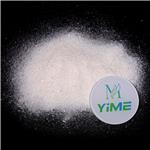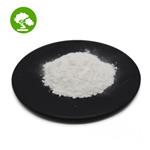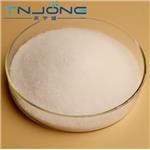- ETHYL CELLULOSE
-

- $40.00 / 1KG
-
2024-04-19
- CAS:9004-57-3
- Min. Order: 1KG
- Purity: 99
- Supply Ability: 10000 kilograms/ month
- Ethyl cellulose
-

- $0.00 / 25kg
-
2024-04-12
- CAS:9004-57-3
- Min. Order: 1kg
- Purity: 99%
- Supply Ability: 2000ton
- Ethyl Cellulose
-

- $0.00 / 1kg
-
2024-04-11
- CAS:9004-57-3
- Min. Order: 1kg
- Purity: 99%
- Supply Ability: 1000kg
|
| | Ethyl cellulose Basic information |
| | Ethyl cellulose Chemical Properties |
| Melting point | 240-255 °C | | density | 1.14 g/mL at 25 °C (lit.) | | refractive index | n20/D 1.47(lit.) | | storage temp. | 2-8°C | | solubility | esters, aromatic hydrocarbons, alcohols and ketones: soluble | | form | powder | | color | White to slightly yellow | | Specific Gravity | 1.14 | | Water Solubility | insoluble | | Merck | 14,3781 | | Dielectric constant | 2.8(Ambient) | | EPA Substance Registry System | Ethyl cellulose (9004-57-3) |
| | Ethyl cellulose Usage And Synthesis |
| Chemical Properties | Ethylcellulose is a tasteless, free-flowing, white to light tan-colored
powder. | | Chemical Properties | white to slightly yellowish powder | | Chemical Properties | Ethyl celluloses are low density polymers (1070–1180 kg.m–3) with solubilities depending on the degree of ethylation; usually commercial grade contains 44–48% ethoxyl functional groups. Solid masses of ethylcellulose exhibit low absorption of moisture, excellent dimen�sional stability and low temperature toughness and impact resistance. Chemically they are less resistant towards acids than cellulose esters but much more resistant to alkalis. They can be processed by injection molding. Because ethylcellulose is soluble in a wide variety of solvents, it provides a wide variety of varnish formulations. Benzylcelluloses yield plastics with excellent dielectric properties and chemical stability.
| | Uses | In the manufacture of plastics and lacquers. Pharmaceutic aid (tablet binder). | | Uses | ethyl cellulose is a binder, film former, and thickener. It is used in suntan gels, creams, and lotions. This is the ethyl ether of cellulose. | | Uses | Film-former in coatings, hot-melt adhesives and transfer inks and as a plastic coating for a variety of substrates. | | Uses | Used as a binder and filler in dry vitamin preparations, as a component of protective coatings for vitamin and mineral tablets, and as a fixative in flavoring compounds. It is a cellulose ether containing ethyoxy groups attached by an ether linkage and containing an anhydrous basis of not more than 2.6 ethoxy groups per anhydroglucose unit. | | Preparation | Ethyl cellulose is prepared by reacting cellulose with caustic to form caustic cellulose, which is then reacted with chloroethane to form ethyl cellulose. Plasticgrade material contains 44-48% ethoxyl.
Although not as resistant as cellulose esters to acids, it is much more resistant to bases. An outstanding feature is its toughness at low temperatures. | | Production Methods | Ethylcellulose is prepared by treating purified cellulose (sourced
from chemical-grade cotton linters and wood pulp) with an alkaline
solution, followed by ethylation of the alkali cellulose with
chloroethane as shown below, where R represents the cellulose
radical:
RONa + C2H5Cl→ROC2H5+NaCl
The manner in which the ethyl group is added to cellulose can be
described by the degree of substitution (DS). The DS designates the
average number of hydroxyl positions on the anhydroglucose unit
that have been reacted with ethyl chloride. Since each anhydroglucose
unit of the cellulose molecule has three hydroxyl groups, the
maximum value for DS is three. | | Definition | ChEBI: Ethyl cellulose is a glycoside. | | Brand name | Aquacoat ECD (FMC);Ethocel (Dow Chemical). | | Pharmaceutical Applications | Ethylcellulose is widely used in oral and topical pharmaceutical
formulations.
The main use of ethylcellulose in oral formulations is as a
hydrophobic coating agent for tablets and granules.Ethylcellulose
coatings are used to modify the release of a drug, to mask
an unpleasant taste, or to improve the stability of a formulation; for
example, where granules are coated with ethylcellulose to inhibit
oxidation. Modified-release tablet formulations may also be
produced using ethylcellulose as a matrix former.
Ethylcellulose, dissolved in an organic solvent or solvent
mixture, can be used on its own to produce water-insoluble films.
Higher-viscosity ethylcellulose grades tend to produce stronger and
more durable films. Ethylcellulose films may be modified to alter
their solubility, by the addition of hypromellose or a
plasticizer. An aqueous polymer dispersion
(or latex) of ethylcellulose such as Aquacoat ECD (FMC
Biopolymer) or Surelease (Colorcon) may also be used to produce
ethylcellulose films without the need for organic solvents.
Drug release through ethylcellulose-coated dosage forms can be
controlled by diffusion through the film coating. This can be a slow
process unless a large surface area (e.g. pellets or granules compared
with tablets) is utilized. In those instances, aqueous ethylcellulose
dispersions are generally used to coat granules or pellets.
Ethylcellulose-coated beads and granules have also demonstrated
the ability to absorb pressure and hence protect the coating from
fracture during compression.
High-viscosity grades of ethylcellulose are used in drug microencapsulation.
Release of a drug from an ethylcellulose microcapsule is a
function of the microcapsule wall thickness and surface area.
In tablet formulations, ethylcellulose may additionally be
employed as a binder, the ethylcellulose being blended dry or wetgranulated
with a solvent such as ethanol (95%). Ethylcellulose
produces hard tablets with low friability, although they may
demonstrate poor dissolution.
Ethylcellulose has also been used as an agent for delivering
therapeutic agents from oral (e.g. dental) appliances.
In topical formulations, ethylcellulose is used as a thickening
agent in creams, lotions, or gels, provided an appropriate solvent is
used. Ethylcellulose has been studied as a stabilizer for
emulsions.
Ethylcellulose is additionally used in cosmetics and food
products. | | Safety Profile | Low toxicity by
ingestion and skin contact. A skin irritant.
When heated to decomposition it emits
acrid smoke and irritating fumes | | Safety | Ethylcellulose is widely used in oral and topical pharmaceutical
formulations. It is also used in food products. Ethylcellulose is not
metabolized following oral consumption and is therefore a
noncalorific substance. Because ethylcellulose is not metabolized it
is not recommended for parenteral products; parenteral use may be
harmful to the kidneys.
Ethylcellulose is generally regarded as a nontoxic, nonallergenic,
and nonirritating material.
As ethylcellulose is not considered to be a health hazard, the
WHO has not specified an acceptable daily intake. The highest
reported level used in an oral product is 308.8 mg in an oral
sustained release tablet.
LD50 (rabbit, skin): >5 g/kg
LD50 (rat, oral): >5 g/kg | | storage | Ethylcellulose is a stable, slightly hygroscopic material. It is
chemically resistant to alkalis, both dilute and concentrated, and
to salt solutions, although it is more sensitive to acidic materials
than are cellulose esters.
Ethylcellulose is subject to oxidative degradation in the presence
of sunlight or UV light at elevated temperatures. This may be
prevented by the use of antioxidant and chemical additives that
absorb light in the 230–340nm range.
Ethylcellulose should be stored at a temperature not exceeding
32°C (90°F) in a dry area away from all sources of heat. It should
not be stored next to peroxides or other oxidizing agents. | | Incompatibilities | Incompatible with paraffin wax and microcrystalline wax. | | Regulatory Status | GRAS listed. Accepted for use as a food additive in Europe.
Included in the FDA Inactive Ingredients Database (oral capsules,
suspensions and tablets; topical emulsions and vaginal preparations).
Included in nonparenteral medicines licensed in Europe.
Included in the Canadian List of Acceptable Non-medicinal
Ingredients. |
| | Ethyl cellulose Preparation Products And Raw materials |
|